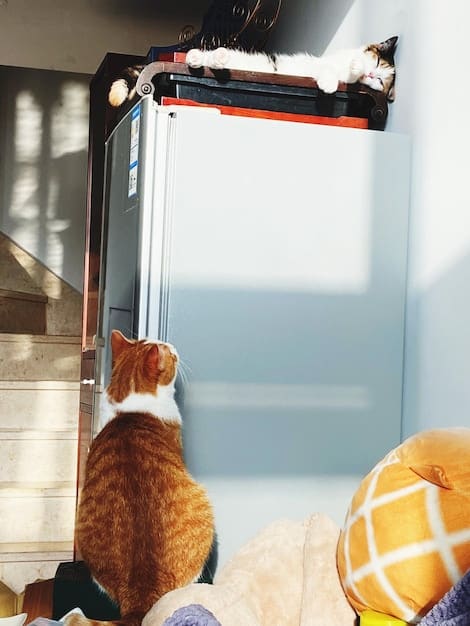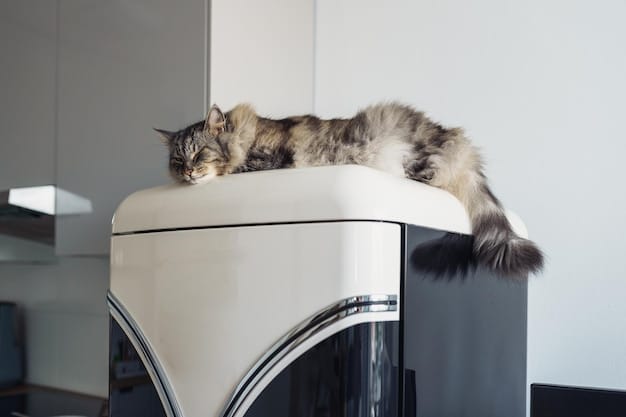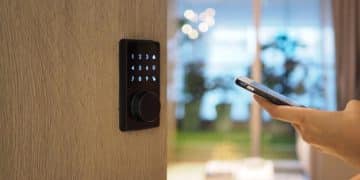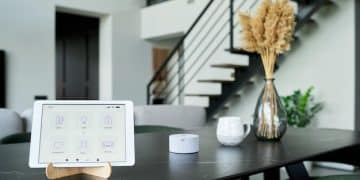Smart Home Automation for Pet Owners: Safety & Happiness

Smart home automation for pet owners enhances the lives of furry friends through automated feeders, smart pet doors, and environmental controls, ensuring their safety, comfort, and happiness, even when their humans are away.
Discover how smart home automation for pet owners can transform your home into a safe, comfortable, and stimulating environment for your beloved companions, enhancing their well-being and giving you peace of mind.
Smart Home Automation: A Paw-sitive Change for Pet Owners
Smart home technology is no longer exclusive to human comfort; it’s revolutionizing pet care as well. The integration of automated systems provides innovative solutions that cater to the unique needs of our furry, scaled, or feathered companions. From monitoring their activities to managing their feeding schedules and ensuring their safety, the possibilities are endless.
This technology offers pet owners considerable peace of mind. Knowing that you can remotely monitor your pet or guarantee they are well-fed, even when you’re stuck at work, is invaluable. This is especially useful for pets with medical conditions or those prone to separation anxiety.

Key Benefits of Automating Your Home for Pets
Implementing smart home automation for pets offers numerous advantages beyond basic convenience. It ensures consistent care, enhances safety, and even provides entertainment, leading to happier and healthier pets.
Here are some key benefits:
Enhanced Safety Measures
Smart home devices enable real-time monitoring and responses to potential dangers. For instance, smart smoke detectors can send alerts directly to your smartphone, while smart cameras allow you to check on your pet’s well-being and safety remotely.
Consistent Care Routines
Automated systems like smart feeders and water fountains ensure your pets receive the proper nutrition and hydration, regardless of your schedule. This is particularly crucial for pets with specific dietary requirements or medical conditions.
- Automated feeding schedules: Maintaining consistent meal times helps regulate your pet’s metabolism and prevents overeating.
- Remote monitoring: Smart cameras allow you to observe your pet’s behavior and environment, ensuring their safety and well-being.
- Environmental control: Smart thermostats and humidity sensors ensure your pet is always comfortable, regardless of the weather outside.
Automating your home provides a structured and reliable care environment that enhances your pet’s well-being in many ways.
Essential Smart Home Devices for Pet Owners
Numerous devices tailored to pet care are available in the realm of smart home technology. To select the most appropriate devices, it’s essential to consider your pet’s specific needs, behavior, and overall health.
The following devices are deemed indispensable by many pet owners:
Smart Feeders
These devices automate the dispensing of food, ensuring your pet receives the correct portion at the scheduled time. Many smart feeders can be controlled via smartphone apps, allowing you to adjust meal times and portion sizes remotely.
Smart Pet Doors
Offering your pet the freedom to go outside without needing constant supervision, these doors can be programmed to recognize your pet’s microchip or a special collar tag, preventing unwanted animals from entering your home. This is especially useful for cats who prefer to roam or dogs who need frequent bathroom breaks.
- Microchip recognition: Ensures only your pet can use the door, keeping unwanted animals out.
- Scheduled access: Set specific times for your pet to go outside, maintaining a consistent routine.
- Remote monitoring: Some doors come with cameras, allowing you to see when your pet uses the door.
Choosing the right smart devices ensures a custom-tailored environment for your pet, meeting their unique needs and enhancing their quality of life.

Creating a Comfortable Environment with Smart Tech
Maintaining a comfortable environment is essential to your pet’s well-being. Smart home automation allows you to control various environmental factors to ensure your pet remains comfortable, regardless of the weather or your location.
Environmental control involves several factors:
Smart Climate Control
Smart thermostats and humidity sensors enable you to maintain a consistent temperature and humidity level in your home. This is crucial for pets sensitive to temperature changes, such as short-haired dogs or cats. You can set schedules to adjust the temperature based on the time of day, ensuring your pet is always comfortable.
Automated Lighting
Smart lighting systems can be programmed to mimic natural daylight, providing a more comfortable environment for pets left alone during the day. You can also set the lights to dim in the evening, signaling to your pet that it’s time to rest.
Enhancing your pet’s environment through automated systems promotes not only their short-term comfort but also their long-term health and happiness.
Maintaining a Safe and Secure Environment Remotely
Remote monitoring is a significant benefit of smart home automation for pet owners. Whether you’re at work, traveling, or simply in another room, you can always check on your pet and ensure their safety. Smart cameras, in particular, offer a window into your pet’s world.
Here’s how to ensure a safe and secure environment:
Smart Cameras and Monitoring Systems
These devices let you see, hear, and even interact with your pet remotely. Many smart cameras come with two-way audio, allowing you to speak to your pet and calm them down if they seem anxious. Some also have treat-dispensing features, providing positive reinforcement even when you’re not there.
Security Systems Integration
Integrating your pet-related smart devices with your home security system enhances overall safety. For example, if a smoke detector goes off while you’re away, you can receive real-time alerts and view live camera feeds to assess the situation and take appropriate action.
- Real-time alerts: Receive notifications on your smartphone about any unusual activity or potential dangers.
- Two-way audio: Communicate with your pet to alleviate anxiety and provide reassurance.
- Remote access: Monitor your pet from anywhere in the world, ensuring their safety and well-being.
Using technology to oversee your pet remotely can drastically improve not only your peace of mind but also contribute towards a safer and more secure lifestyle for your four-legged friend.
Troubleshooting Common Smart Home Issues
Like any technology, smart home devices can experience glitches or require troubleshooting. Understanding common issues and how to resolve them can save you time and frustration, ensuring your pet continues to benefit from these devices without interruption.
Here are some ways to tackle potential situations:
Connectivity Challenges
One of the most common issues is connectivity problems. Ensure your Wi-Fi network is stable and that all your smart devices are within range. If you experience frequent disconnections, consider upgrading your router or adding a Wi-Fi extender.
Device Malfunctions
Sometimes, devices may simply malfunction. Check the manufacturer’s website for troubleshooting guides or contact customer support. Regular maintenance, such as cleaning sensors and updating firmware, can also prevent issues.
- Check Wi-Fi connectivity: Ensure your devices are connected to a stable network.
- Update firmware: Keep your devices updated with the latest software to fix bugs and improve performance.
- Consult troubleshooting guides: Refer to the manufacturer’s website for solutions to common issues.
Taking a proactive approach to troubleshooting can prevent minor problems from escalating, ensuring a seamless experience with your smart home pet care system.
Future Trends in Smart Pet Care
The smart pet care industry is continually evolving, with new innovations emerging regularly. Staying informed about these trends allows you to anticipate future needs and proactively improve your pet’s care.
Here’s a look at what’s on the horizon:
AI-Powered Pet Care
Artificial intelligence is playing an increasingly significant role in pet care. AI-powered devices can analyze your pet’s behavior, detect anomalies, and provide personalized recommendations. For example, smart collars can track your pet’s activity levels and alert you to any potential health issues.
Integration with Wearable Technology
Wearable devices, such as GPS trackers and health monitors, are becoming more sophisticated. These devices can provide real-time data on your pet’s location, heart rate, and sleep patterns, helping you stay informed about their health and well-being.
Remaining updated on the latest trends within smart pet technology enables you to not only provide an evolving standard of care but also ensure your pet benefits from advancements built specifically around their well-being.
| Key Point | Brief Description |
|---|---|
| 🐾 Automated Feeding | Ensures consistent meal times and portion control for pets. |
| 🚪 Smart Pet Doors | Grants pets freedom to roam while keeping unwanted animals out. |
| 🌡️ Climate Control | Maintains optimal temperature and humidity for pet comfort. |
| 📹 Remote Monitoring | Allows pet owners to check on their pets remotely. |
FAQ
▼
Smart home automation enhances pet safety through remote monitoring, ensures consistent care with automated feeders, and improves comfort via climate control, providing peace of mind for pet owners.
▼
Smart feeders maintain portion control and consistent feeding schedules, which helps regulate your pet’s metabolism and prevents overeating, promoting overall health and well-being.
▼
Yes, smart pet doors are generally safe. They use microchip or collar recognition to prevent unwanted animals from entering, and some offer scheduled access and remote monitoring for added security.
▼
Smart thermostats and humidity sensors maintain a consistent and comfortable environment for your pet, especially beneficial for those sensitive to temperature changes, ensuring they are always comfortable regardless of the weather.
▼
First, check your Wi-Fi connection and ensure the device is within range. Then, update the device’s firmware or consult the manufacturer’s troubleshooting guide. Contact customer support if the issue persists.
Conclusion
Integrating smart home automation for pet owners not only simplifies pet care but also significantly enhances the safety, comfort, and happiness of our animal companions. By leveraging the latest technologies, we can create environments that cater to their unique needs, providing peace of mind and a higher quality of life for both pets and their owners.





